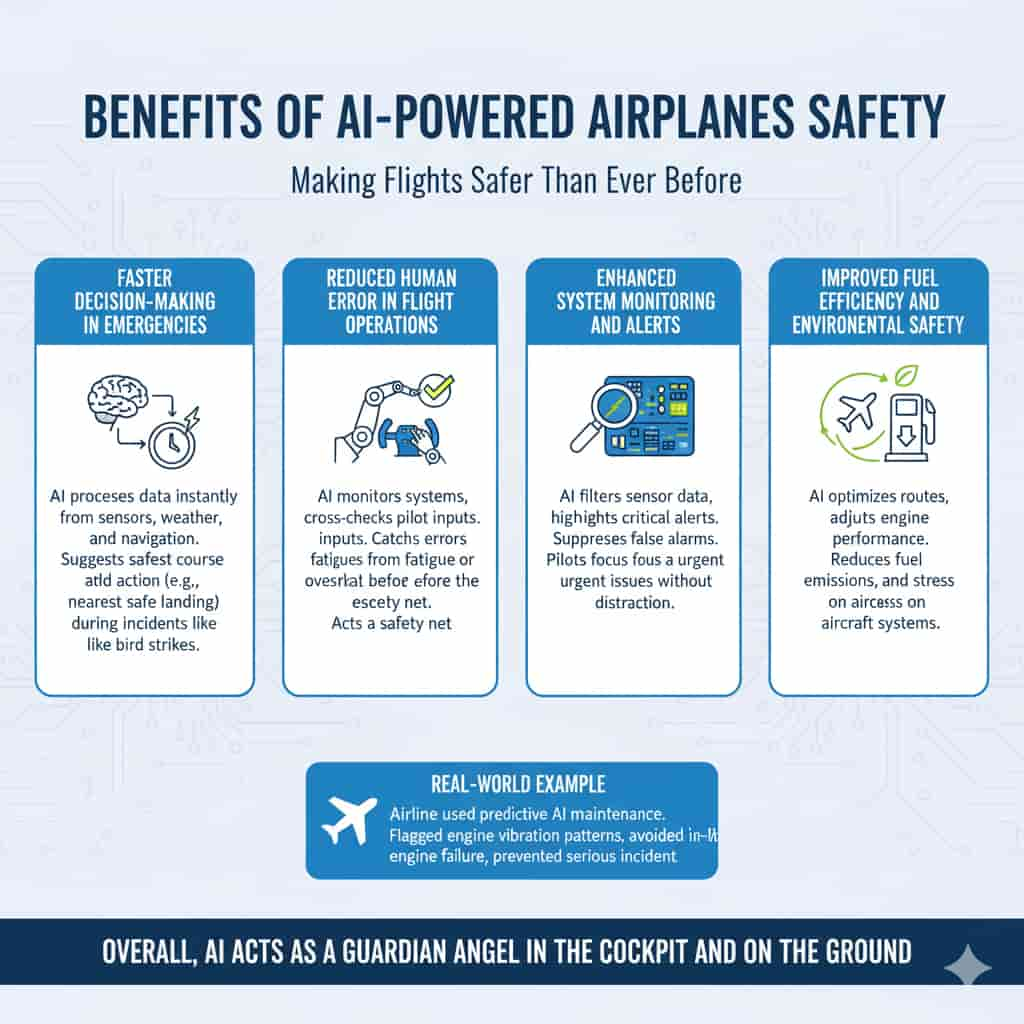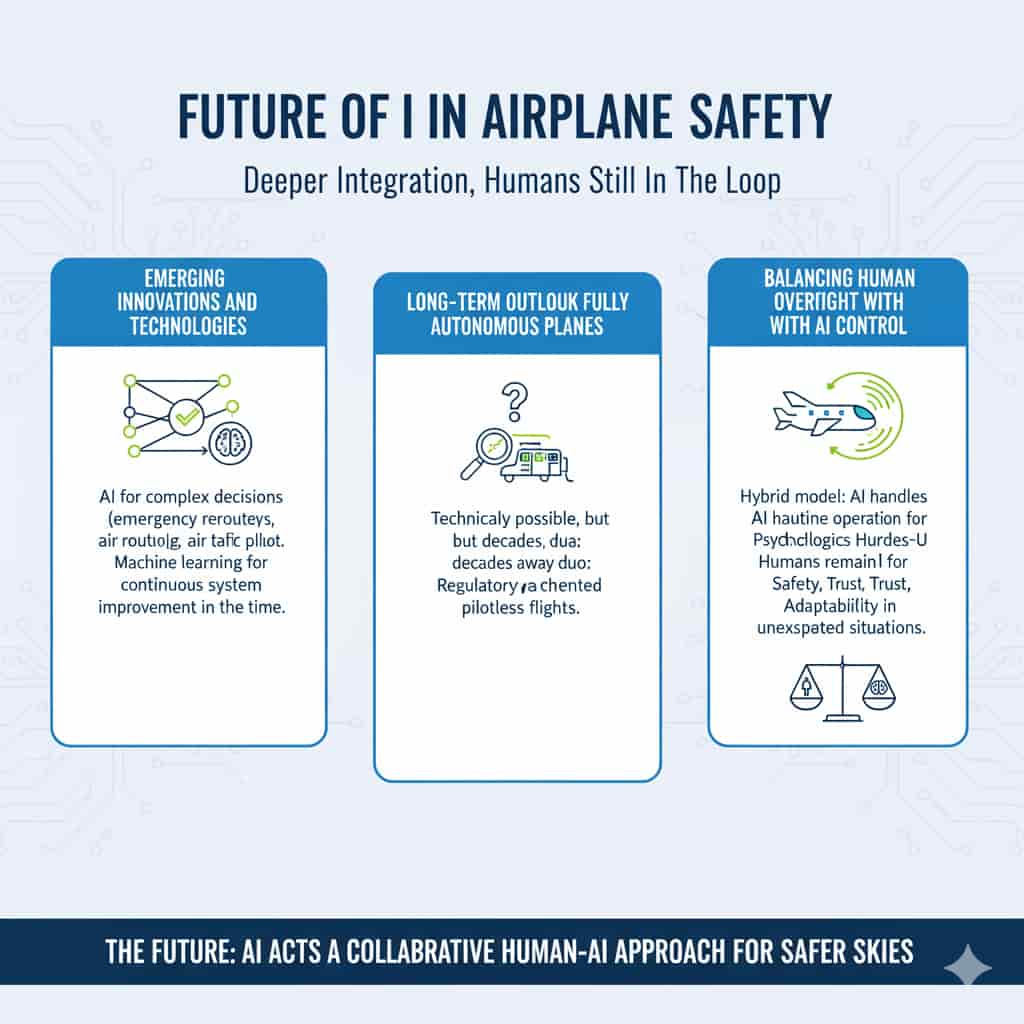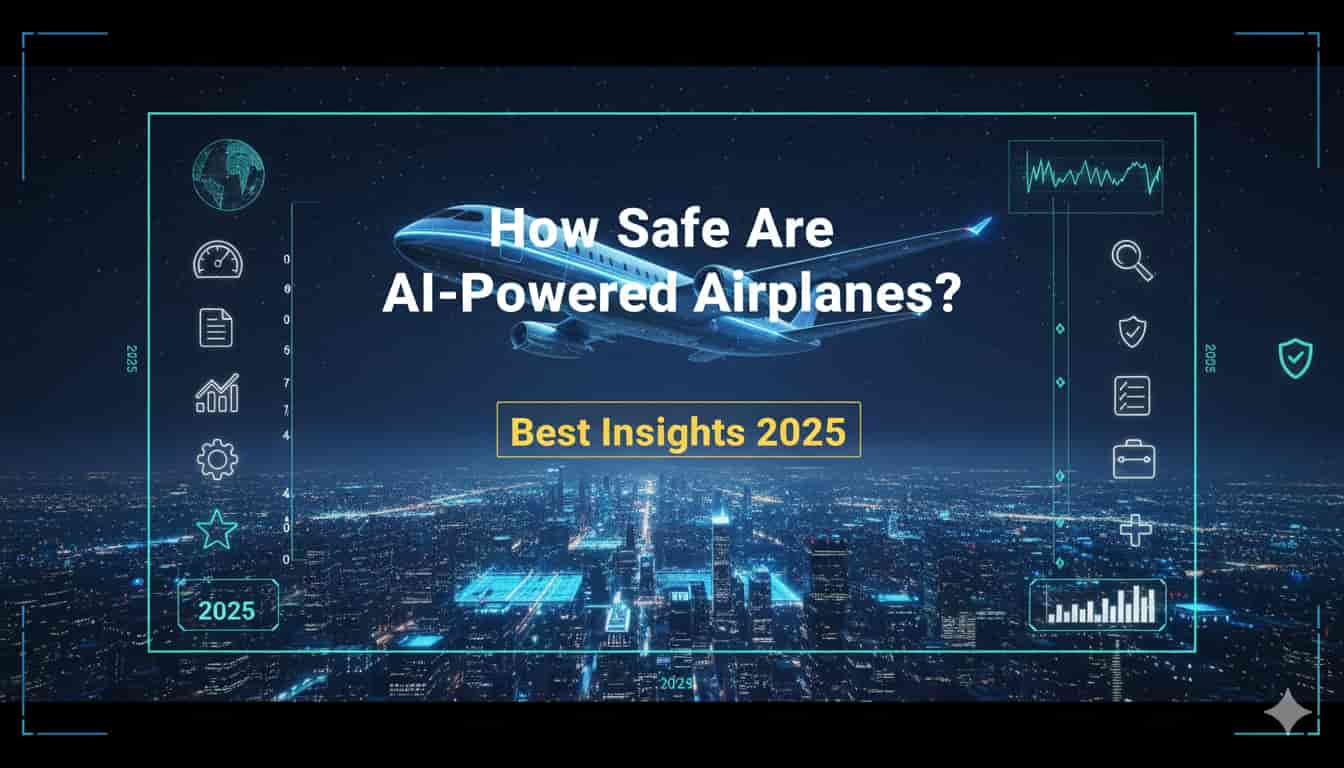1. Introduction
Air travel has always been one of the safest modes of transportation, thanks to strict protocols and advanced technology. Now, with artificial intelligence entering the cockpit, many travelers wonder: How safe are AI-powered airplanes? Let’s explore the role of AI in aviation, its benefits, risks, and what the future may hold.
2. What Are AI-Powered Airplanes?
When we hear the term “AI-powered airplanes,” we’re not talking about pilotless aircraft flying passengers around just yet. Instead, we’re referring to airplanes that use artificial intelligence to support, improve, and sometimes automate key functions in flight. AI is not a single tool but a broad system of algorithms, sensors, and decision-making technologies working together.
In simple terms, AI in aviation means machines can analyze massive amounts of data, learn patterns, and make predictions faster than humans. Think of it as a co-pilot that never gets tired, distracted, or stressed, always ready to assist.
Some everyday examples already exist. Modern autopilot systems are an early form of AI, capable of maintaining altitude, heading, and speed with minimal pilot input. More advanced versions are now able to manage entire flight paths, optimize routes for fuel efficiency, and adjust to weather conditions in real time.
AI isn’t limited to the cockpit. Ground operations also benefit, with AI systems tracking aircraft health, predicting maintenance needs, and even scheduling repairs before parts fail. For passengers, AI shows up in facial recognition boarding systems, baggage tracking, and personalized customer service.
So, when we say “AI-powered airplanes,” we mean aircraft that integrate AI technologies across flight operations, maintenance, safety monitoring, and passenger services. While the final decision still rests with human pilots and controllers, AI has become a silent partner that makes flying safer, smoother, and more efficient.
3. How Is AI Used in Aviation Today?
Artificial intelligence is already deeply embedded in aviation. While many of these systems work quietly behind the scenes, their impact is significant. Let’s look at where AI is most commonly applied today.
Flight Operations and Autopilot Systems (Using AI-powered Airplanes)
Most travelers don’t realize that autopilot handles the majority of a flight’s cruise phase. Today’s AI-enhanced systems go beyond maintaining direction and altitude. They analyze real-time weather, turbulence reports, and traffic conditions to suggest safer and more efficient flight paths. Some systems can even land planes in low-visibility conditions with minimal human input.
Predictive Maintenance and Diagnostics (Using AI-powered Airplanes)
Airplanes are complex machines with thousands of parts. Traditionally, maintenance followed fixed schedules or relied on manual inspections. Now, AI algorithms track sensor data from engines, hydraulics, and avionics to predict when a part might fail. This “predictive maintenance” reduces downtime, prevents costly breakdowns, and most importantly, prevents safety incidents before they occur.
Air Traffic Control and Navigation Support (Using AI-powered Airplanes)
AI is also reshaping how airplanes communicate with each other and with air traffic controllers. By analyzing flight patterns, AI helps reduce congestion in busy skies, predicts potential conflicts, and provides optimized routes. This improves safety and efficiency while reducing delays for passengers.
Passenger Safety and Service Improvements (Using AI-powered Airplanes)
For passengers, AI enhances safety indirectly. Intelligent cabin monitoring systems detect unusual sounds, vibrations, or temperature changes that may signal a problem. Customer-facing AI tools, like real-time translation and personalized updates, reduce stress and keep travelers informed.
In short, AI is already a trusted partner in the aviation ecosystem. It helps pilots focus on big-picture decisions while managing repetitive, data-heavy tasks in the background. This partnership between human expertise and machine intelligence forms the foundation for safer skies.
4. Benefits of AI-powered Airplanes Safety
The integration of AI into aviation safety is not just about making flights smoother; it’s about making them safer than ever before. Here are some of the biggest advantages AI brings to the table.
Faster Decision-Making in Emergencies using AI-powered Airplanes
In an emergency, seconds matter. AI can instantly process data from multiple sensor engines, navigation, weather, and more, then suggest the safest course of action. For example, if a bird strike damages an engine, AI can calculate the nearest safe landing options while pilots focus on flying the aircraft.
Reduced Human Error in Flight Operations using AI-powered Airplanes
Human error has historically been the leading cause of aviation accidents. Fatigue, stress, or simple oversight can lead to mistakes. AI reduces this risk by constantly monitoring systems and cross-checking pilot inputs. It acts like a safety net, catching errors before they escalate into danger.
Enhanced System Monitoring and Alerts (Using AI-powered Airplanes)
Airplanes are packed with sensors, but data overload can overwhelm humans. AI filters this information, highlighting only the most critical alerts while suppressing false alarms. This prevents pilots from being distracted and ensures that the most urgent issues get immediate attention.
Improved Fuel Efficiency and Environmental Safety to AI-powered Airplanes
AI doesn’t just improve safety; it also contributes to sustainability. By optimizing routes and adjusting engine performance, AI reduces fuel consumption and emissions. A smoother flight path not only saves money but also avoids unnecessary stress on aircraft systems, indirectly improving safety.
Real-World Example of AI-powered Airplanes
One airline using predictive AI maintenance avoided an in-flight engine failure because the system flagged unusual vibration patterns long before a human inspector could notice. That early warning prevented a serious safety incident and kept passengers safe.
Overall, AI acts as a guardian angel in the cockpit and on the ground, supporting pilots, preventing mistakes, and safeguarding passengers from risks that may otherwise go unnoticed.

5. Potential Risks and Concerns
While AI offers many benefits, it’s not without risks. Understanding these challenges helps balance optimism with caution.
Technical Failures and AI Malfunctions
No technology is flawless. Software bugs, sensor errors, or unexpected conditions can cause AI to malfunction. If the system provides incorrect data or makes a wrong prediction, the consequences could be serious. This is why human oversight remains essential.
Cybersecurity and Hacking Risks (Using AI-powered Airplanes)
As airplanes become more connected, cybersecurity becomes a bigger concern. Hackers targeting AI systems could disrupt navigation, communication, or onboard safety features. Even a minor breach could compromise trust in AI-powered aviation.
Overreliance on Automation (Using AI-powered Airplanes)
Pilots may become overly dependent on automation, resulting in a decline in their manual flying skills. This “automation complacency” has already contributed to some past aviation incidents. AI should assist pilots, not replace their judgment or expertise.
Ethical and Accountability Challenges
If an AI system makes a mistake that leads to an accident, who is accountable, the airline, the manufacturer, or the regulators? Defining responsibility in an AI-driven world remains a complex challenge for aviation authorities.
These risks don’t mean AI-powered airplanes are unsafe, but they do highlight the need for balance, AI should support humans, not replace them entirely.
Read more: Can AI Reduce Traffic Congestion in Big Cities? 7 Ways
6. How Safe Are AI-Powered Airplanes Compared to Traditional Aircraft?
Safety is always the top priority in aviation. So, how do AI-powered airplanes measure up against traditional ones?
Current Safety Statistics and Trends
Aviation is already one of the safest industries, with accident rates steadily declining over decades. AI contributes to this trend by catching problems earlier, preventing breakdowns, and helping pilots avoid errors. While AI-driven incidents are rare, human error continues to account for the majority of accidents.
Comparing Accident Causes: Human vs. Machine Error
Studies show that around 70–80% of aviation accidents are caused by human error. AI can help reduce this number by monitoring pilot actions and providing corrective guidance. Machine error, though possible, is far less frequent when systems are properly tested and maintained.
Industry and Regulatory Perspectives
Regulators like the FAA and EASA recognize AI’s potential but require rigorous testing before approval. Airlines adopt AI gradually, ensuring systems are thoroughly vetted. The consensus is that AI makes flying safer overall when combined with human oversight.
In essence, AI-powered airplanes don’t replace traditional aircraft, they enhance them, making already safe skies even safer.
7. What Experts and Airlines Are Saying
Industry leaders have mixed but generally optimistic views on AI in aviation.
Aviation Authorities
Organizations like the FAA (Federal Aviation Administration) and EASA (European Union Aviation Safety Agency) acknowledge AI’s potential but stress the need for robust safety checks. They emphasize that human pilots will remain critical for the foreseeable future.
Airlines and Adoption
Major airlines are already using AI for predictive maintenance, route optimization, and customer service. Some are testing advanced autopilot features that allow near-autonomous landings under supervision. These gradual steps build trust among regulators and passengers.
Pilots and Engineers
Pilots often describe AI as a helpful assistant rather than a replacement. Engineers see it as a way to make airplanes more reliable. The general agreement: AI should enhance human capability, not replace it.
8. How Regulations Ensure AI Safety in Aviation
Aviation is one of the most heavily regulated industries, and AI must pass strict standards before being implemented.
Certification and Compliance Processes
Every AI system must go through rigorous certification, including stress tests, fail-safe checks, and redundancy evaluations. This ensures that no single system failure can endanger an aircraft.
Role of International Aviation Bodies
Organizations like ICAO (International Civil Aviation Organization) set global standards for AI use in aviation. They ensure that systems are interoperable across countries and compatible with existing safety frameworks.
Standards for Testing and Reliability
Before AI systems are deployed, they undergo simulations covering millions of scenarios, from severe storms to equipment malfunctions. Only after passing these exhaustive tests are they approved for real-world use.
These regulations ensure that AI in aviation is not experimental, it’s thoroughly tested, proven, and continuously monitored.
Read more: How AI in Aviation Is Powering Smarter Battery Monitoring
9. Future of AI in Airplane Safety
The future of aviation will likely see even deeper AI integration, but with humans still in the loop.
Emerging Innovations and Technologies
AI is being developed to handle more complex decisions, such as rerouting during emergencies or coordinating directly with air traffic systems. Machine learning will allow systems to get smarter over time.
Long-Term Outlook for Fully Autonomous Planes
Fully autonomous passenger flights are technically possible, but they may be decades away due to regulatory, ethical, and psychological hurdles. Most experts agree that passengers are not ready to fly without pilots on board.
Balancing Human Oversight with AI Control
The likely future is a hybrid model, where AI handles routine operations while humans remain in command. This balance ensures safety, trust, and adaptability in unexpected situations.

10. Frequently Asked Questions
Are AI-powered airplanes currently flying passengers?
Yes, many commercial flights already use AI-driven systems such as autopilot, predictive maintenance, and navigation assistance. However, no passenger planes are fully autonomous.
Can AI fully replace pilots in the future?
Technically possible, but unlikely anytime soon. Passengers and regulators value human oversight, especially in emergencies.
How do airlines test AI systems for safety?
AI systems undergo extensive simulations, ground testing, and supervised trial flights before approval. They must prove reliability under countless scenarios.
What happens if an AI system fails mid-flight?
Airplanes are designed with multiple backups. If one system fails, others take over. Pilots are always trained to assume manual control when necessary.
Are passengers comfortable with AI-powered airplanes?
Surveys show mixed feelings. Many appreciate the safety improvements AI brings, but full pilotless planes still raise concerns.
Which airlines are leading in AI adoption?
Airlines in North America, Europe, and Asia are leading the way, using AI for maintenance, fuel optimization, and passenger service.
How do governments regulate AI in aviation?
Regulators like the FAA and EASA enforce strict certification processes. AI must meet the same, if not higher, safety standards as traditional systems.
Is AI safer than human pilots in preventing crashes?
AI reduces human error, the leading cause of crashes. But ultimate safety comes from combining human judgment with AI support.
What role do pilots still play in AI-powered planes?
Pilots remain in command. They monitor AI, make final decisions, and take control during unusual or emergency situations.
How soon could we see fully autonomous passenger planes?
Experts predict at least 20–30 years before full autonomy is possible, mainly due to regulatory and public trust issues.
Read more: The Future of AI in Aviation 2025: A Flight Path to Success
11. Final Thoughts
AI is transforming aviation safety by reducing human error, improving decision-making, and predicting problems before they occur. While risks like technical failures and cybersecurity challenges remain, regulations and human oversight ensure that flying is safer than ever. For now, AI-powered airplanes represent a powerful partnership between humans and machines, a partnership designed to keep the skies safe.


1 thought on “How Safe Are AI-Powered Airplanes? Best Insights 2025”